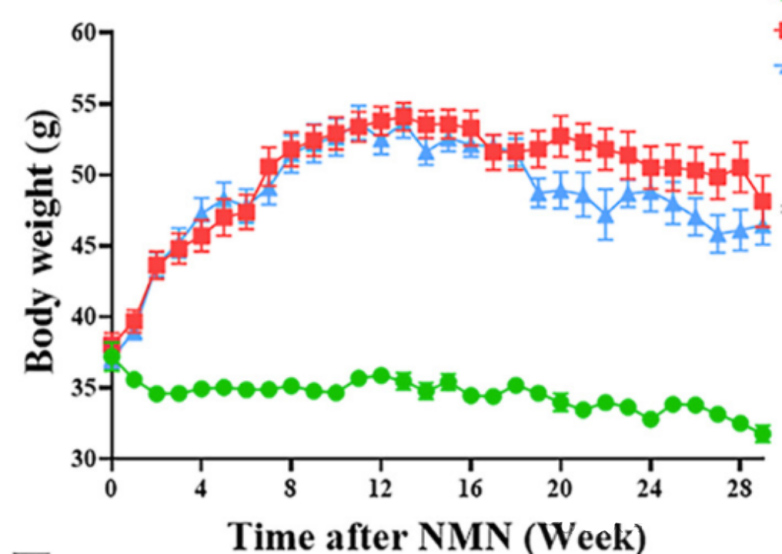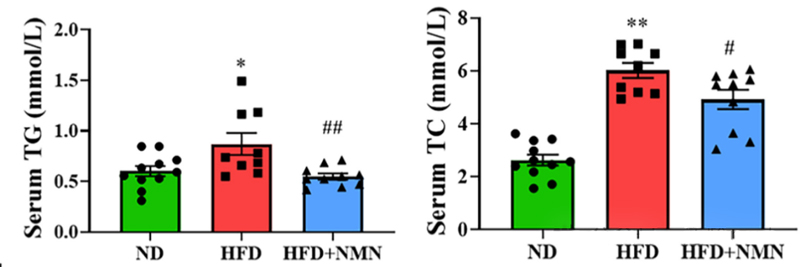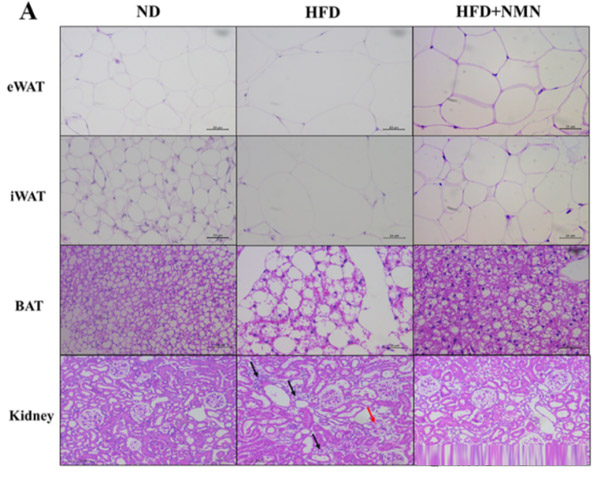
Feb 20, 2025 / Author: China Glutathione suppliers & NMN manufacturers
In the microscopic world of the cell, niacinamide adenine dinucleotide (NAD+) is involved in hundreds of REDOX reactions in the cell and is required for key metabolic processes such as glycolysis, the tricarboxylic acid cycle, mitochondrial respiration and fatty acid beta-oxidation.
With age there is a gradual decline in the level of NAD+ in the body and the various functions of cells are affected accordingly.
Improving the biosynthesis of NAD+ promises to be an effective strategy to combat the various pathophysiological changes in the natural ageing process.
The molecular formula for nicotinamide adenine dinucleotide (NAD+) is C21H27N7O14P2.
It consists of one molecule of nicotinamide, one molecule of adenine, two molecules of ribose and two molecules of phosphoric acid.
In this formula, the elements carbon (C), hydrogen (H), nitrogen (N), oxygen (O), phosphorus (P) and so on are included, which together form the chemical structure of NAD+, giving it the functional basis for participating in numerous REDOX reactions in the living body.
NMN is the precursor substance of NAD+, synthesized from niacinamide (the amide form of vitamin B3) and 5 '-phosphoribose pyrophosphate by niacinamide phosphoribosyl transferase.
Many studies have shown that NMN has shown remarkable effects in the treatment of metabolic diseases and other conditions.
For example, it improves the level of NAD+ in pancreatic islets, reduces apoptosis and oxidative stress after severe burns and thereby improves islet function;
It can also treat liver steatosis and insulin resistance caused by diet and age, protect heart function in mice with myocardial ischemia/reperfusion injury, relieve neuropathy in diabetic mice, and improve oocyte quality in obese mice.
However, most current studies on NMN have focused on short-term interventions and single organs, and there are few studies on the effects of long-term NMN use on multiple organs.
In the last decade, scientists have discovered that sirtuins, a Nad-dependent deacetylase, have a potential protective effect against a variety of metabolic diseases.
SIRT1 and SIRT3 in mammals can enhance fat oxidation and prevent metabolic diseases by acting on multiple signaling pathways.
The strategy of combating metabolic damage by increasing levels of intracellular NAD plus by activating sirtuins has received considerable attention.
In January this year, a research team from the Institute of Nutrition and Health at the School of Public Health, Wuhan University of Science and Technology, and the Key Laboratory of Occupational Hazard Identification and Control in Hubei Province published a study in the Journal of Nutrition that speculated that long-term administration of NMN may protect the fat, muscle and kidney tissue of mice fed a high-fat diet (HFD).
And this effect may be achieved by affecting the autophagy pathway.
To test the efficacy of NMN, the team conducted a series of experiments.
They used 14-month-old male C57BL/6J mice and divided the mice into three groups:
Normal diet (ND) group, high fat diet (HFD) group and high fat diet + 400mg/kg NMN (HFD + NMN) group.
Mice in the HFD group were fed a diet with 60 percent of their calories coming from fat, while the ND group was fed a normal maintenance diet.
Before the NMN intervention, the researchers measured the water intake of the mice for two weeks, and then added NMN to the drinking water of the HFD + NMN group at a dose of 400mg/kg, and changed it every 3 days according to the water intake of the mice.
During the experiment, the researchers performed a number of tests on the mice.
To assess the motor ability of the mice, they performed grip strength tests, suspension tests, rotating rod tests, and balance beam tests.
In the grip test, the mice were required to grasp a device, and the researchers assessed the muscle strength of the mice by measuring the maximum force of their grip;
The suspension test tested the grip strength, endurance, balance and motor coordination of the mice, which were held upside down on the barbed wire for as long as possible.
The rotating rod test is used to measure the balance and motor coordination of mice, which need to maintain balance on a gradually accelerating rotating bar;
The balance beam test assesses motor coordination by placing mice on a special wooden board and observing their ability to balance while walking.
These test results will be an important basis to measure the effect of NMN on the body function of mice.
In terms of weight and body composition, mice fed a high-fat diet for a long time gained significantly in weight, while mice in the HFD + NMN group lost significantly in weight after 4 months of NMN intervention.
By 20 months, the NMN intervention also significantly reduced the mice's total body fat content and liver fat content.
As assessed by frailties index, NMN-treated mice showed significant improvements in both total and skin-related scores, suggesting that NMN delayed the aging process induced by a high-fat diet.

The curve of weight change of mice over time. The weight of mice in HFD group increased with time, while the weight of mice in HFD + NMN group decreased significantly after 4 months of NMN intervention, which was in sharp contrast to that in HFD group (P < 0.01), intuitively indicating that NMN can inhibit HFD-induced weight gain in mice.
In terms of energy metabolism and physical activity, the oxygen consumption of mice in HFD group was significantly lower than that in ND group during both light and dark cycles, while the NMN intervention significantly increased the oxygen consumption of mice.
The HFD group of mice had a decreased respiratory exchange rate, indicating that they relied primarily on fatty acids as an energy source, while the NMN intervention increased the respiratory exchange rate in the mice, meaning that the energy source was shifted more to glucose.
The NMN-treated mice showed a significant increase in physical activity at night, but there was no significant difference in food intake among the groups.
This set of results suggests that NMN enhances energy metabolism caused by a high-fat diet.
For glucose and lipid metabolism, oral glucose tolerance tests showed significantly reduced glucose tolerance in HFD group mice, while long-term NMN administration significantly enhanced tolerance to glucose load in HFD mice.
In terms of blood lipids, NMN significantly reduced HFD-induced triglyceride (TG) and low-density lipoprotein cholesterol (LDL cholesterol) levels, and also slightly improved total cholesterol (TC) levels, but had less effect on high-density lipoprotein cholesterol (HDL cholesterol) levels.

NMN administration significantly improved serum levels of triglyceride (TG), total cholesterol (TC), and low density lipoprotein cholesterol (LDL cholesterol).
In terms of pathological changes, the researchers conducted a detailed examination of fat and kidney tissue from the mice.
H&E staining showed that fat cells of HFD mice were significantly enlarged, lipid droplets vacuolated in the cytoplasm, glomerular atrophy and inflammatory cell infiltration in some renal tubulointerstitial tissues occurred, while NMN intervention significantly reduced the cross-sectional area of fat cells, improved the arrangement and morphology of fat cells, and alleviated the pathological changes of kidneys.
Masson staining showed that NMN intervention significantly reduced the degree of fibrosis in fat and kidney tissue.
Immunohistochemical results showed that the expression of p16 in muscle and kidney tissue of HFD mice was significantly increased, while its expression was significantly decreased after NMN intervention.
NMN intervention also reduced the expression of macrophage marker F4/80 in adipose tissue and decreased the expression level of IL-1β in muscle and kidney tissue, further demonstrating the inhibitory effect of NMN on inflammation.

Long-term administration of NMN improved the pathological changes of peripheral tissue in HFD-treated mice. In HFD + NMN group, the cross-sectional area of adipocytes was significantly reduced, the cells were more closely arranged, and the pathological changes of kidney tissues were also significantly reduced, which directly showed the improvement effect of NMN on tissue morphology.
In terms of skeletal muscle function, the grip strength of HFD group was significantly decreased, while the NMN intervention significantly improved the grip strength of mice.
The results of the suspension test and the rotating rod test also showed that the HFD group of mice performed poorly on both tests, while the NMN treated mice significantly increased their residence time on the rotating rod.
H&E staining showed that NMN-treated mice had a larger cross-sectional area and more tightly packed cells, suggesting that NMN improved skeletal muscle function in mice on a high-fat diet.
The researchers examined the effect of NMN on levels of NAD + and the expression of SIRT1 and SIRT3 proteins.
The results found that the level of NAD in the blood of the mice in the HFD group was significantly lower than in the ND group, while NMN increased significantly after administration.
In fat and skeletal muscle tissue, SIRT1 protein expression in HFD group was significantly decreased, but significantly increased after NMN intervention.
The expression of SIRT3 protein in adipose tissue was not significantly different among all groups, but in skeletal muscle tissue, the expression of SIRT3 protein in HFD group was higher than that in ND group, and it was further increased after NMN intervention.
In renal tissues, there were no significant differences in the expression of SIRT1 and SIRT3 proteins among all groups.
This suggests that in this study, NMN may play a protective role mainly by activating SIRT1 and its downstream pathway.
The researchers also examined the expression of autophagy associated proteins and found that LC3II/I protein levels were elevated in the skeletal muscle and white adipose tissue (eWAT) of the epididymal group of HFD mice, but decreased in the kidneys.
The expression of p62 protein was increased in kidney tissue of HFD group mice, but decreased in skeletal muscle and eWAT.
NMN intervention inhibited excessive autophagy in adipose tissue and skeletal muscle tissue, and restored stalled autophagy flux in kidney tissue.
However, no studies have explored the reasons for this difference, so further studies are needed to identify the main target organs and effector molecules of NMN in different models.
Taken together, the results of this study preliminatively prove that NMN can indeed reduce the physiological decline of high-fat diet mice by affecting the autophagy pathway.
In terms of changes in body weight and body composition, NMN significantly inhibited age-related weight gain and reduced body fat percentage in mice.
Moreover, this weight and fat loss did not result from a reduction in food intake, but rather from NMN changing the mice's activity patterns and energy metabolism.
NMN led to a significant increase in oxygen consumption and activity at night, and also changed their energy substrate utilization, shifting the mice from relying primarily on fatty acid oxidation for energy to using more carbohydrates.
It was like giving the mice an "upgrade" to their body's metabolic system, allowing them to use energy more efficiently and reduce fat accumulation.
In terms of metabolic diseases, NMN improves the situation of glucose and lipid metabolism disorders, alleviating the problems of high-fat diet-induced impaired glucose tolerance and elevated plasma TG/LDL levels.
This efficacy echoes previous findings and further confirms the potential of NMN in the prevention and treatment of metabolic diseases.
Studies have shown that NMN can regulate the expression of genes related to fat synthesis, transport and uptake in the liver, promote fatty acid oxidation, and reduce the accumulation of fat in the liver.
NMN may also play a positive intervention role in metabolic syndrome by enhancing insulin sensitivity and improving blood glucose regulation.
NMN also significantly improved the pathological changes and inflammatory responses of multiple organs in mice.
In adipose tissue, it reduces the size of fat cells, improves cell arrangement, reduces fibrosis, and inhibits the infiltration of inflammatory cells.
In kidney tissue, NMN alleviates glomerular atrophy and inflammatory cell infiltration, alleviating renal fibrosis.
These results suggest that NMN is able to protect organs from damage caused by a high-fat diet and maintain the normal structure and function of organs.
In addition, NMN also showed certain anti-aging effects by reducing the expression level of p16 in muscle and kidney tissues.
p16 is a protein closely related to cellular senescence, and the decrease of its expression level means that the cellular senescence process is slowed down.
In terms of skeletal muscle function, NMN improved grip strength, motor coordination and balance, increased the cross-sectional area of the gastrocnemius muscle and improved muscle mass in mice.
This has important potential implications for sarcopenia and motor function decline, which are common in the elderly.
Muscle strength and function gradually decline with age, and NMN is expected to be an effective means to improve muscle function and improve the quality of life of the elderly.
In terms of mechanism of action, NMN activates related proteins such as SIRT1 and SIRT3 by increasing the level of NAD +.
SIRT1 plays an important role in multiple tissues, regulating cell metabolism, stress response, and aging processes.
In this study, NMN increased the expression of SIRT1 in fat and skeletal muscle tissue, which may be one of the key mechanisms for its improvement of metabolic function, reduction of inflammatory response and delay of aging.
SIRT3 mainly plays a role in mitochondria, participating in the regulation of mitochondrial energy metabolism and antioxidant defense.
In skeletal muscle, NMN enhances SIRT3 expression, which may contribute to improving mitochondrial function and enhancing the oxidative metabolic capacity of muscle.
The regulation of autophagy by NMN also provides strong support for its anti-aging effect.
Autophagy is a self-degrading process in cells that can remove damaged proteins and organelles and maintain the stability of the intracellular environment.
Abnormal changes in autophagy levels occur during obesity and aging induced by a high-fat diet.
This study found that NMN was able to inhibit excessive autophagy in adipose tissue and skeletal muscle, while restoring stalled autophagy flux in kidney tissue.
This precise regulation of autophagy helps to maintain the normal function of cells and reduce cell damage and aging.
Although NMN has shown many exciting effects in mouse experiments, there is still a big gap from animal experiments to clinical applications.
There are differences between species, and the results of experiments in mice cannot simply be extrapolated to humans.
The safety and efficacy of NMN in humans require further large-scale clinical trials.
Although NMN has been well tolerated in animal experiments, it is not known whether it will cause side effects during long-term use in humans.
The optimal dosage and way of use of NMN also need further study.
Nevertheless, NMN's research results still bring us new thinking and exploration directions.
With the deepening of the research, we are expected to further understand the mechanism of NMN, optimize its use scheme, so that it can be better applied in the field of human health.
In the future, perhaps NMN can really become a powerful weapon to prevent and treat age-related diseases and improve human health.
But until then, we need to be rational and cautious.
There have been a lot of NMN-related products on the market, and some businesses have exaggerated its efficacy, promoting NMN as a "miracle drug", it seems that taking it can immediately achieve reverse age growth and eternal youth.
From scientific research to practical application, there is still a long way to go.
Most of the existing studies are based on animal models.
Before NMN can be used in humans, a large number of rigorous clinical trials are needed to ensure its safety and efficacy.
In terms of effectiveness, although NMN has performed well in improving metabolic function, reducing inflammation, and increasing muscle strength in mice, it is uncertain whether it can achieve the same effect in humans.
Different populations may also respond differently to NMN.
For example, there is a difference in the level and metabolic state of the body between young and old, healthy people and people with specific diseases, and the effect of NMN may vary in them.
More detailed studies in different populations are needed to determine the effectiveness of NMN in humans.
The market for NMN also needs regulation.
At present, the NMN product market is mixed, and the product quality is uneven.
The production process of some products is not up to standard, which may cause the purity and activity of NMN cannot be guaranteed.
There are also some products with exaggerated claims that mislead consumers.
This not only harms the interests of consumers, but may also affect the reputation of the entire field of NMN research.
Relevant departments need to strengthen the supervision of the NMN market and formulate strict quality standards and norms to ensure that consumers can buy safe and effective products.
Supplier Introduction: China glutathione supplier and NMN manufacturer GSHworld, the company mainly develops biotechnology and industrialization. As a global pioneer in enzymatic catalytic ATP regeneration technology, our company advocates green production and is committed to providing customers with better and more environmentally friendly products and services. Glutathione Manufacturer,NMN Factory,Citicoline Sodium supplier,China NMN manufacturers
+86-755-23577295
+86 18718790084
Room 832, Building 12, Shenzhen Bay Science and Technology Ecological Park, Yuehai Street, Nanshan District, Shenzhen China